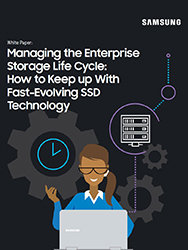Content delivery networks (CDNs) have been around since the days when most internet connections were measured in kilobits per second (Kbps) or less, rather than the megabits or even gigabits per second that we have now. Driven by the rise of streaming video, online games and social media networks, CDNs have today become a large part of internet infrastructure, with a massive volume of data being delivered to end users who demand high-definition content with low latency.
To meet the demand for content delivery, data is stored as close to the end user as possible, reducing traffic over ISP backbones and improving the user’s experience. But satisfying this demand also requires high-speed, reliable and affordable data storage — and lots of it.
Optimizing SSD Performance for Today’s CDN
We built the new Samsung 860DCT enterprise SATA SSD to offer price and performance optimized for CDN networks.
Content delivery vendors are anxious to leverage SSD performance to improve throughput and response times, reduce power consumption, and achieve better reliability than hard drive based systems. Yet with dozens, hundreds or even thousands of cache servers deployed all over the world, CDN vendors are rightfully sensitive to costs — often leading them to try consumer-grade SSDs.
The consumer-grade drives, however, tend to have steep drop-offs in performance after a few months in service, with high write amplification failures — prohibiting administrators from performing network-wide firmware updates, and lacking lacking Self-Monitoring, Analysis, and Reporting (S.M.A.R.T) attributes to manage the life of the drives as well as the ability to schedule trim as needed.
Manage the Enterprise Storage Life Cycle
Download this guide to improve your storage planning and evaluation processes. Download Now
On the other hand, CDN servers don’t need a lot of write performance: traffic is highly read sequential — essentially Write Once, Read Many — which is atypical for many other enterprise workloads. That’s why the 860DCT is optimized for sequential reads, delivering 100 percent read quality of service (QoS) at 150 microsecond latency.
Enterprise-Grade Reliability, Consumer-Level Affordability
Consumer-class SSDs can support many parallel sequential read processes, even under enterprise workloads, so we took the approach of using consumer-class SSD technology, while adding an enterprise-grade drive controller and software.
The 860DCT delivers about 10 percent better read performance than competitive SATA SSDs, lower power consumption and higher reliability — with throttling of throughput in the event that temperatures exceed recommended limits. This ensures reliability even if airflow is restricted; in fact, the drives can generally operate with only convection cooling in use within a server.
This combined approach has the additional benefit of lowering the cost considerably compared to standard enterprise SATA SSDs.
With many content delivery servers being co-located in ISP facilities, the systems must be able to handle higher temperatures than might be typical of data centers, along with lower power consumption. A Linux smartmontools package, with utilities such as smartctl and smartd, allows administrators to monitor drive temperatures and other S.M.A.R.T. attributes on the drives.
The Samsung 860DCT is optimized for the demands of today’s content delivery networks. With many organizations implementing such servers for their own use, as well as deploying them worldwide to optimize delivery of data to end users, the 860DCT is designed to meet these organizational needs by offering excellent performance at a lower cost than other enterprise-class SSDs.
Find the best storage solutions for your business by checking out our award-winning selection of SSDs for the enterprise.








